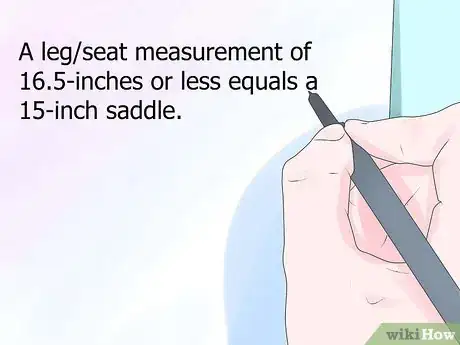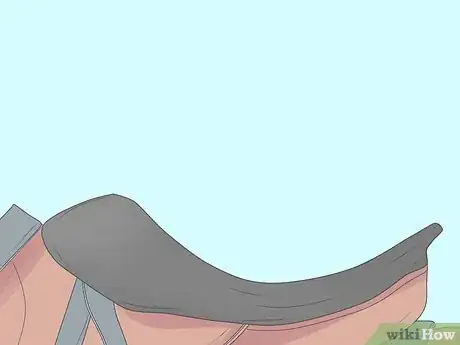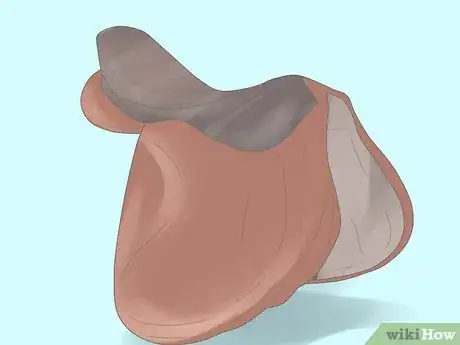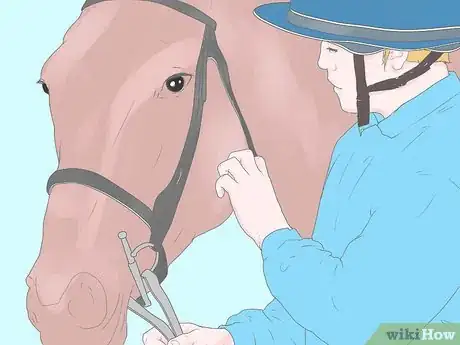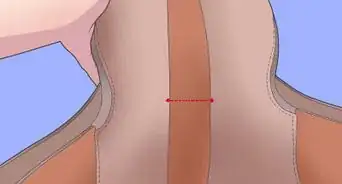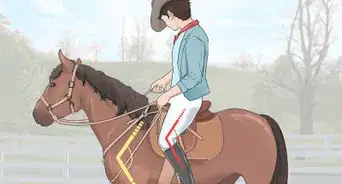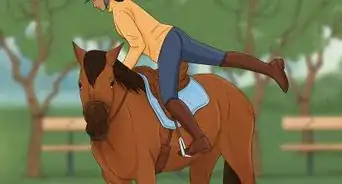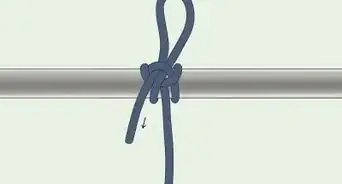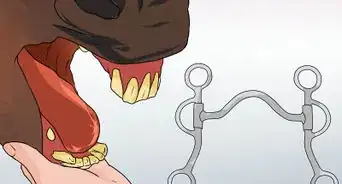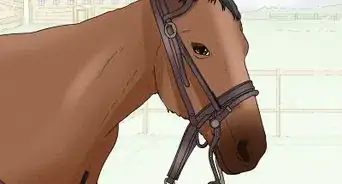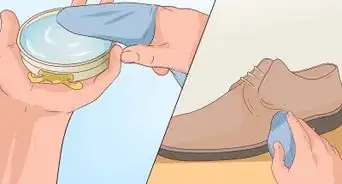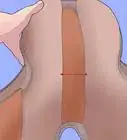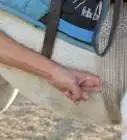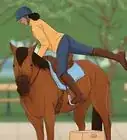This article was co-authored by Ryan Corrigan, LVT, VTS-EVN. Ryan Corrigan is a Licensed Veterinary Technician in California. She received her Bachelor of Science in Veterinary Technology from Purdue University in 2010. She is also a Member of the Academy of Equine Veterinary Nursing Technicians since 2011.
This article has been viewed 217,534 times.
A good fitting saddle is imperative for the comfort of both horse and rider. It improves the way your horse will work, making them more willing. Instead of looking for the best-looking saddle or the cheapest deal, take a few minutes to get a proper saddle measurement and outfit your horse in the best tack for its body.
Steps
Fitting the Saddle to the Rider
-
1Decide on the type of saddle you want. Before you consider purchasing a saddle, you need to make a firm decision on the specific type of riding you hope to do. There are 2 general categories of riding: English and western. English saddles come in traditional English, hunter, dressage, and jumper varieties. Western saddle options include traditional western, endurance, barrel racing, and roping styles.
- If you are working with a trainer, ask them for a recommendation! They can provide you with a better idea of what type of saddle you should choose and how much it should cost.
-
2Take your seat measurement. The chair-like area of the saddle that you sit in is known as the ‘seat’. Seats come in a variety of sizes for the multiple body-types riders have. To measure your seat, sit in a chair with your back against the chair back and your feet on the floor. Use a soft measuring tape and measure the distance from your kneecap to the crease in your hip.
- Your seat length should vary somewhere between 13 to 19 inches (33.0 to 48.3 cm) for an adult.
- You can visit an online seat converter and enter in your physical attributes (weight, height, etc.) to get an immediate measurement instead of measuring yourself.
Advertisement -
3Find your size in an English saddle. Use your seat measurement to determine the seat size (and therefore the saddle size) of an English saddle. The measurement/size approximately equates as:
- A leg/seat measurement of 16.5 inches (41.9 cm) or less equals a 15 in (38 cm) saddle.
- A leg/seat measurement of 16.5 to 18.5 inches (41.9 to 47.0 cm) equals a 16 in (41 cm) saddle.
- A leg/seat measurement of 18.5 to 20 inches (47.0 to 50.8 cm) equals a 16.5 in (42 cm) saddle.
- A leg/seat measurement of 20 to 21.5 inches (50.8 to 54.6 cm) equals a 17 in (43 cm) saddle.
- A leg/seat measurement of 21.5 to 23 inches (54.6 to 58.4 cm) equals a 17.5 in (44 cm) saddle.
- A leg/seat measurement larger than 23 inches (58.4 cm) will fit an 18 to 19 in (46 to 48 cm) saddle.[1]
-
4Determine your size in a western saddle. The measurement of seat is a bit different for western saddles than it is for English saddles. The easiest conversion is to subtract two inches from the size of your English saddle, and you’ll be left with the size of your western saddle. Use the following chart to determine your Western saddle size based on your leg/seat measurement:
- A leg/seat measurement of 16.5 inches (41.9 cm) or less equals a 13 in (33 cm) saddle.
- A leg/seat measurement of 16.5 to 18.5 inches (41.9 to 47.0 cm) equals a 14 in (36 cm) saddle.
- A leg/seat measurement of 18.5 to 20 inches (47.0 to 50.8 cm) equals a 15 in (38 cm) saddle.
- A leg/seat measurement of 20 to 21.5 inches (50.8 to 54.6 cm) equals a 15.5 in (39 cm) saddle.
- A leg/seat measurement of 21.5 to 23 inches (54.6 to 58.4 cm) equals a 16 in (41 cm) saddle.
- A leg/seat measurement larger than 23 inches (58.4 cm) will fit an 17 to 18 in (43 to 46 cm) saddle.
-
5Check an English saddle for proper fit by placing 4 fingers on the cantle. To tell if your English saddle fits you, put it on a saw-horse or your horse and sit in it as you would for riding. You should be able to fit 4 fingers on the cantle, the raised portion of the back of the saddle, behind your seat. If you can’t fit at least 4 fingers, the saddle is too small. If you can fit a whole hand or more flat against the cantle, the saddle is too big.
-
6Use your fingers to check a western saddle for proper fit. Test the fit of a western saddle by sitting on it as you would for riding on either a saw-horse or your horse. A well-fitting saddle will allow 3 to 4 fingers to fit between the fork/swell and your thigh. If you can fit more than 4 fingers, the saddle is too large. If you can’t fit at least 3 fingers, the saddle is too small.[2]
-
7Measure the stirrup length using your armpit. Before you settle on a saddle, be sure that it offers the correct stirrup length for your body type. Although different styles require different stirrup lengths (jumpers use short stirrups, for example), you can get a ballpark idea of your stirrup length by standing to the side of the saddle, and pulling the stirrup up to your armpit. When the stirrup fits in the hollow of your armpit, it is close to the length you will require when riding.
- Keep in mind that you can always buy different stirrups for a saddle that fits you.
Fitting a Saddle to Your Horse
-
1Position the saddle. Place the prospective saddle on your horse’s back without a saddle pad or blanket. Move it so that it is in the accurate position: the front of the saddle should rest on the withers without blocking the shoulder and the back should go no further than the last rib bone. Move the saddle back and forth a few times to find the ‘sweet spot’. You can also achieve this by rocking the saddle back and forth over the horse’s spine to ensure that it is well balanced.
-
2Check the gullet. The gullet is the long empty space that runs length-wise along the spine of the horse, and fitting this properly is crucial for preventing nerve pain and spinal injuries in your horse. A proper fitting saddle will allow you to see all the way through the gullet when viewed from the back. You should be able to fit 2 to 3 fingers stacked on top of the withers inside the gullet, just below the fork/swell (western) or the pommel (English).
- If you can’t fit at least 2 fingers in the gullet from the front, the saddle tree is too small for your horse and will pinch their spine.
- If you can fit more than 3 fingers in the gullet from the front, then the saddle tree is too large and will cause rocking and saddle sores on your horse.
-
3Inspect the bar slope. The bars are the part of the saddle that form the gullet and hold the saddle on the horse’s back. The bars run along the length of the spine, and should be in contact with the entirety of the horse’s back if the saddle fits. If the bars are too straight, they will only meet with the withers and the croup of the horse’s back, causing briding. If the bars are too curved, they will touch only the center of the horse’s back and cause the saddle to rock in between the withers and the croup.
-
4Make sure the bar flare is visible at the front of the saddle tree. The bars flare outwards at the front and back of the saddle to prevent chafing and rubbing while riding. If the saddle fits, the front of the saddle tree should flare out slightly. If the saddle is too small, there won’t be any bar flare evident and it will be very uncomfortable to your horse.
-
5Check the bar width. Some horses are very wide across their backs, while others are very narrow. To tell if the saddle fits your horse’s back size, see where the bars sit. If they rest very high up, almost on top of the spine, then the saddle is too narrow. If the bars slide down very far past the spine, then the saddle is too wide.
- The bar width is closely related to the gullet clearance; a too-narrow bar width will cause a larger gullet space while a too-wide bar width will cause little to no gullet clearance.[3]
-
6Test the girth. When you get the girth tightened on your horse, you should be able to fit four fingers side-by-side between the front of the girth and your horse’s shoulders. An ill-fitting saddle may cause the girth to fall forwards or slide backwards.
-
7Pay attention to your horse’s response. Throughout the saddle testing/fitting process, keep an eye on your horse. If the saddle isn’t the right size or uncomfortable, your horse will show it in their body language.
-
8Ask a professional to measure your horse for the best fit. Many saddle companies employ professionals who will come to your location and do a fitting. Call or email the company you are considering purchasing from to see if they offer this service. Another good option is to ask you vet if they would be willing to do a fitting. Veterinarians are knowledgeable about anatomy and well-qualified to fit your horse for a saddle.
Expert Q&A
-
QuestionHow do you measure the legs and seat of a western saddle?
 Ryan Corrigan, LVT, VTS-EVNRyan Corrigan is a Licensed Veterinary Technician in California. She received her Bachelor of Science in Veterinary Technology from Purdue University in 2010. She is also a Member of the Academy of Equine Veterinary Nursing Technicians since 2011.
Ryan Corrigan, LVT, VTS-EVNRyan Corrigan is a Licensed Veterinary Technician in California. She received her Bachelor of Science in Veterinary Technology from Purdue University in 2010. She is also a Member of the Academy of Equine Veterinary Nursing Technicians since 2011.
Licensed Veterinary Technician To measure a western saddle you should measure the distance between the highest point of the cantle to the top of the gullet. If your legs are longer, you may need a larger seat than your measurement so that your knees don’t hit the front fenders. Ideally your thighs shouldn’t touch the front of the swell.
To measure a western saddle you should measure the distance between the highest point of the cantle to the top of the gullet. If your legs are longer, you may need a larger seat than your measurement so that your knees don’t hit the front fenders. Ideally your thighs shouldn’t touch the front of the swell.
Warnings
- Proceed with caution when putting on a saddle. Horses sometimes don't like it, and can harm you or other objects or people around you.⧼thumbs_response⧽
Things You'll Need
- A selection of saddles - narrow, medium and wide
- measuring tape
References
About This Article
To fit a saddle to a rider, start by sitting in a flat chair and measuring the distance between your kneecap and the crease in your hip, which will give you your seat measurement. Then, use your seat measurement to find the right size saddle, and keep in mind that western and English saddles fit differently. You should also stand to the side of the saddle and pull one of the stirrups up to the hollow of your armpit, which will give you a ballpark of how long your stirrups should be. For more tips from our Veterinary co-author, like how to fit a saddle to a horse, scroll down!


